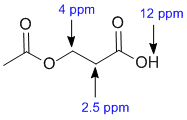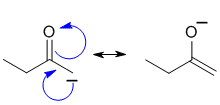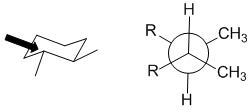Chem 351 Final Fall 2018
Here is an post-mortem analysis / "how to" for
the FINAL. The questions are split by the sections. At the start of each section
are a few suggestions of what to look for or how to tackle the question type.
RELATIVE PROPERTIES:
Identify the controlling feature,
which is not always as obvious as
it may appear. Look for two pairs of similar systems to compare that
have
minimal differences in structure.
| Qu 1: |
Boiling points are controlled by intermolecular forces. For alkenes (and alkanes) where we are limited to weaker forces, increasing the surface area will increase the forces to be overcome and cause a higher boiling point. More branched structures tend to be more spherical and have less surface area in contact, thus lower boiling point. |
 |
| Qu 2: |
A question about stability carbocations. Remember that the order of stability is tertiary > secondary > primary and that allylic carbocations are further stabilised by resonance... draw the contributors to work out which one is the most stable. |
 |
| Qu 3: |
This is a radical substitution reaction of alkanes (i.e. sp3 C-H bonds). For chlorination, the reaction is controlled by a combination of the relative reactivity of the radical formed and the number of H that yield that radical. The relative reactivity of tertiary : secondary : primary systems are 5.2 : 3.9 : 1. The calculations are outlined on the figure on the starting material. |
 |
Qu 4: |
First identify the reaction... SN2.... which will tend to be controlled by the degree of substitution where the general trend is that primary > secondary > tertiary. And remember that the reaction is limited to sp3 systems. |
 |
Qu 5: |
Basicity.... the strongest base will produce the most the greatest amount of the conjugate base. The strongest base is the amide ion (associated pKa = 35) then alkoxide (pKa approx. 15) and lastly the tertiary amine (pKa about 10).... for basicity, think about where the e are coming from ? -ve more available than neutral and the electronegativity of the atom (same row) carrying the lone pairs will affect electron availability. |
 |
Qu 6: |
Acidity.... Need to look at the stability of the conjugate bases and consider the factors that affect that stability. We have NH and CH to compare.... NH will be more acidic since N is more electronegative than C and therefore better able to stabilise the -ve charge. The two NH systems are also adjacent to C=O where a resonance interaction will further stabilise the conjugate bases. |
 |
Qu 7: |
First identify the reaction...alcohol dehydration.... which will tend to be E1 and therefore the stability of the intermediate carbocation. Recall that for C+ stability tertiary > secondary > primary (due to e donating properties of alkyl groups). |
t-butanol > 2-butanol > 1-butanol |
| Qu 8: |
Chemical shifts of the groups in question in these systems are determined by the position of the H (that is what is changing). Chemical shifts are affected by electronegative atoms (especially such as O) and magnetic anisotropy (due to pi systems). The carboxylic acid H (12ppm) is deshielded by the electronegative O and the acidic character of the group. The methylene -O-CH2- group is affected by the electronegativity O that it is directly attached to (about 4 ppm) and the methylene -CH2-C=O is affected the proximity of the carbonyl group (about 2.5 ppm). |
 |
| Qu 9: |
Mass spectrometry... chlorobenzene will give the molecular ion, m+, at 112 g/mol. The peak at 113 (due to the presence of a single atom of 13C) will be quite small while the peak at 114 (m+2, due to the 37Cl isotope) will be about 1/3 the height of the molecular ion.
|
 (the image shows part of the actual MS) (the image shows part of the actual MS)
|
| Qu 10: |
Counting types of hydrogen |
 |
| Qu 11: |
The number of lines = multiplicity (i.e. coupling) of the signals for each of the positions indicated is determined by the number of neighbours (n) that are of a different type (since H of the same type do not show coupling e.g. the CH2 groups in cyclohexane (where there is only 1 type of H).
|
 |
| Qu 12: |
First identify the reaction...dehydrohalogenation of alkyl halides using strong base and heat which will tend to be E2. Pent-2-ene will be the Zaitsev product which is favoured by smaller bases due to the accessibility of the H that needs to be removed. |
 |
MOLECULAR PROPERTIES
No real method here, really just do you
know various aspects of molecular structure / reactions, applied to each of the questions.
| Qu13: |
The stereochemistry of the tosylate is the same as that of the alcohol because the C-O in unchanged during the reaction that converts the alcohol to the tosylate. |
| Qu14: |
The reaction is SN2 (stereochemistry supports that conclusion) and DMSO is a polar aprotic solvent that enhances the nucleophilicity of the cyanide ion. |
| Qu15: |
The conjugate base with the -ve charge adjacent to the C=O allows for resonance stabilisation which helps stabilise the conjugate base (the image below shows a similar situation). |
| Qu16: |
A tertiary alkyl bromide is most likely to eliminate when treated with sodium ethoxide due to the basicity. |
| Qu17: |
The C in the C=O of the ester is shielded compared the the ketone because of resonance electron donation of the -OR group. |
| Qu18: |
Push the curly arrows! One of the choices is a resonance contributors (check overall charge and changes to sigma bonds). |
 |
REACTIONS:
Three types of questions.
For those
with starting materials work from
the starting materials towards the products using the reagents to "see"
what product to look for.
For those with the product work
backwards....
looking at the functional groups in the products to think about how you
may have got there.
For those wanting reagents look at
the functional groups in the
starting material and products
to try to determine what may have happened. Look at the reagents in
each
option to see what effect they would have on the SM....
| Qu19: |
We should work forwards.... Sodium metal essentially reacts as a base with the acidic H in the alcohol to create the alkoxide ion which will then react as a base when heated with 2-bromobutane via an E2
elimination reaction to give an alkene. |
 |
| Qu20: |
We should work forwards and review the transformation by comparing starting material and product. The carboxylic acid is being converted into an ester. If the acid is made into a nucleophile (use a base) then a nucleophilic substitution can yield the ester. |
 |
| Qu21: |
We should work forwards... the reaction is a radical substitution to an allylic system (check the resonance contributors) |
 |
| Qu22: |
We should work forwards ...an alcohol to the cyanide at the same position means we need to use via a nucleophilic substitution and via SN2 (to avoid carbocation rearrangement).
Therefore convert the -OH into a -Cl using thionyl chloride and then substitute the -Cl for the -CN. Remember that we will need to convert the -OH into a better LG. |
 |
| Qu23: |
We should work forwards... The required alkene is the more highly substituted Zaitsev alkene and therefore simple acid dehydration (E1) will work. |

|
| Qu24: |
We should work forwards...KOtBu will react with an alky bromide when heated to undergo an anti-Zaitsev E2
elimination to give the less highly substituted alkene via removal of the more accessible H. Remember these are 1,2-eliminations so the H is removed from the C adjacent to the C with the Br attached. |
 |
| Qu25: |
We can work forwards...conversion of the alcohol to the alkyl halide using thionyl chloride via a nucleophilic substitution and then a nucleophilic substitution with the thiolate as the nucleophile to give a thio ether (this is a S analogue of the O reaction, a Williamson ether synthesis). Both reactions are SN2, so there is an inversion followed by an inversion so we have overall retention of stereochemistry. |
 |
| Qu26: |
We should work backwards.... the product is an alkene formed using strong base and heat (an E2
elimination) of an alkyl chloride. Given the cyclic nature, you need to consider the stereochemical preference for the H-C-C-Cl to be at 180 degrees which requires that the Cl and H be in axial positions. We also need to ensure that the starting material gives only the enantiomer shown. |
 |
CONFORMATIONAL ANALYSIS:
Understanding the terminology and the
energies involved in
conformational
analysis.
Qu 27:
First, draw the named structure, then to help, count C atoms and check the arrangement of the methyl groups when you match it to the Newman projection.

Qu 28:
The torsional angle between the two methyl groups is 60 degrees in this chair conformation of trans-1,2-dimethylcyclohexane.

Qu 29:
Cis requires that the two chlorine groups are on the same face of the ring. For a chair conformation a cis-1,4- system is going to require a chair with one equatorial and one axial Cl. In a boat conformation make sure the groups are cis-1,4-

Qu30:
The torsional angle between the halogen atoms is 0 degrees in this syn conformation.
Qu31:
The structures are isomeric (same MF) but what type of isomer are they? Comparing the drawings or using models allows one to determine that the two structures are not drawn identically and have the same components (e.g. 2 methyl groups, 2 Cl and 2 H attached to 2 other C) connected in the same order...a closer inspection shows that the Newman projection has (R,S) configurations (i.e. meso) while the wedge hash is (S,S). Therefore, they are best described as diastereomers.
Qu32:
The most stable conformation of trans-1-ethyl-3-fluorocyclohexane will be a chair conformation with the larger ethyl group equatorial and an axial F atom.

Qu33:
In order for the chair conformations to be of equal energy, the two groups will (1) need to be the same and (2) need to be one equatorial and one axial.

Qu34:
In order for a structure to be meso, the two chirality centers will need to have the same set of 4 different substituents and the configurations will need to be opposite. One route to do this is to determine the configurations of the chirality centers or we can recognise the internal mirror plane or the inversion center.

SPECTROSCOPY:
Use any IR information to get the
functional groups. Use the H-NMR
to get the number of types of H, how many of each type from the
integral
and what they are next to from the coupling patterns. Chemical shifts
should
tell you if the group is near -O- or maybe C=O groups etc.
| Qu 35: |
IR shows a carbonyl (i.e. C=O) at 1737 cm-1 which is a high for a typical ketone. 1200 cm-1 suggest C-O. The C-NMR peak for the C=O at 170 ppm suggests a carboxylic acid derivative. The H-NMR has 3 types of H. The 3H doublet at 1.4 ppm,
suggests a -CH3 group next to a CH, the 1H quartet at 3.3 ppm suggests a deshielded CH adjacent to a -CH3 group and the 6H singlet at 3.8ppm 2 x CH3 that have no H neighbours and are deshielded. These pieces of data are consistent with a dimethyl ester. |
 |
| Qu36: |
No major IR bands are reported. The C-NMR shows just two types of C. The H-NMR has 2 types of H. The 3H singlet at 3.3 ppm,
suggests a deshielded -CH3 group without C-H neighbours such as possibly -OCH3. The 2H singlet at 3.7 ppm suggests a deshielded CH2 that is not coupled. Given the structures, looks like we need a symmetrical system (double the integrations). This is consistent with the 1,2-dimethyl ether (recall that H of the same type don't show coupling). |
 |
| Qu37: |
IR shows a carbonyl (i.e. C=O) at 1713 cm-1 which is typical for a ketone as is the C-NMR peak at 202 ppm. The H-NMR has 2 types of H. The 3H singlet at 2.1 ppm,
suggests a -CH3 group without neighbours, and the 1H singlet at 3.6ppm an isolate CH. These pieces of data are consistent with a CH3C(=O)CH- fragment... remember that integration only gives empirical ratios. |
 |
| Qu38: |
No major IR bands are reported. The C-NMR has 3 types of C. The H-NMR has 3 types of H. The 3H doublet at 1.3 ppm,
suggests a -CH3 group next to a CH and the 1H quartet at 4.5 ppm a deshielded CH next to a -CH3. The 6H singlet at 3.3 suggests 2 x -CH3 (isolated and deshielded such as -OCH3). Given the structures, this is a 1,1-dimethyl ether. |
 |
| Qu39: |
The presence of an -OH is shown in the IR at 3350 cm-1 and in the H-NMR (at 1.8 ppm, broad singlet that is exchangeable). The C-NMR has 2 types of C. The H-NMR has 3 types of H. The 6H doublet at 1.2 ppm,
suggests 2 x -CH3 group next to a CH, and the 1H septet at 3.7 ppm a CH next to 6H (i.e. 2 x -CH3 groups). These pieces are consistent with propan-2-ol. |
 |
| Qu40: |
The presence of an -OH is shown in the IR shows an -OH at 3340 cm-1 and in the H-NMR (at 2.3 ppm, broad singlet that is exchangeable). The C-NMR has 3 types of C. The H-NMR has 4 types of H. The 3H triplet at 0.9 ppm,
suggests a -CH3 group next to a CH2, the 2H sextet at 1.6 ppm a CH2 next to 5H (i.e. 1 x -CH3 and 1 x CH2 groups) and the 2H triplet at 3.6pmm suggests a CH2 next to another CH2. These pieces are consistent with propan-1-ol. |
 |






 (the image shows part of the actual MS)
(the image shows part of the actual MS)


















